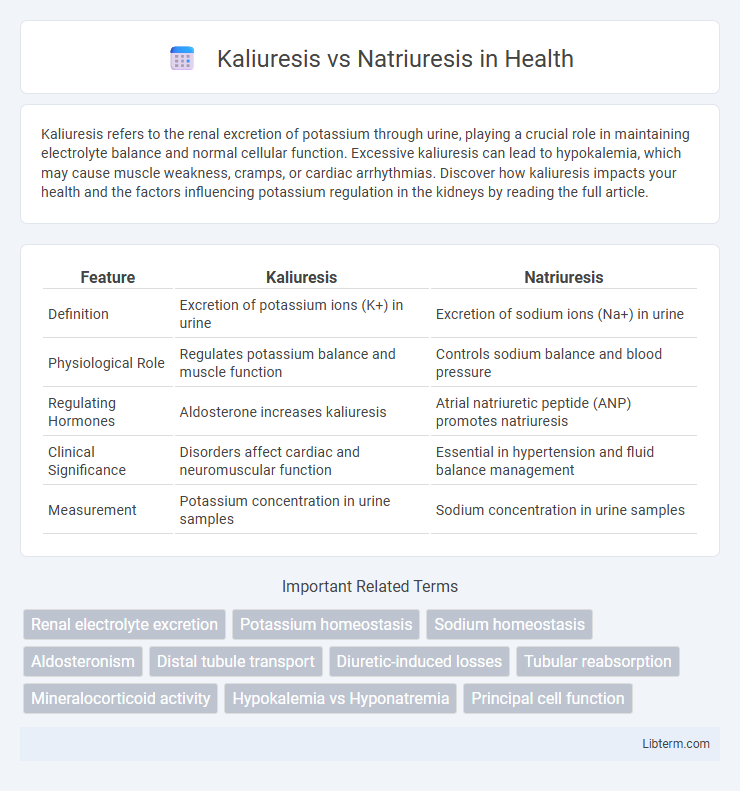Kaliuresis refers to the renal excretion of potassium through urine, playing a crucial role in maintaining electrolyte balance and normal cellular function. Excessive kaliuresis can lead to hypokalemia, which may cause muscle weakness, cramps, or cardiac arrhythmias. Discover how kaliuresis impacts your health and the factors influencing potassium regulation in the kidneys by reading the full article.
Table of Comparison
| Feature | Kaliuresis | Natriuresis |
|---|---|---|
| Definition | Excretion of potassium ions (K+) in urine | Excretion of sodium ions (Na+) in urine |
| Physiological Role | Regulates potassium balance and muscle function | Controls sodium balance and blood pressure |
| Regulating Hormones | Aldosterone increases kaliuresis | Atrial natriuretic peptide (ANP) promotes natriuresis |
| Clinical Significance | Disorders affect cardiac and neuromuscular function | Essential in hypertension and fluid balance management |
| Measurement | Potassium concentration in urine samples | Sodium concentration in urine samples |
Introduction to Kaliuresis and Natriuresis
Kaliuresis refers to the renal excretion of potassium ions (K+) into the urine, a critical process for maintaining cellular function and electrolyte balance. Natriuresis involves the excretion of sodium ions (Na+) by the kidneys, playing a key role in blood pressure regulation and fluid balance. Understanding the mechanisms of kaliuresis and natriuresis is essential for diagnosing and treating disorders related to electrolyte imbalance and hypertension.
Definition of Kaliuresis
Kaliuresis refers to the excretion of potassium ions (K+) in the urine, playing a critical role in maintaining electrolyte balance and proper cellular function. It is primarily regulated by aldosterone, which increases potassium secretion in the distal tubules and collecting ducts of the kidney. In contrast, natriuresis involves the excretion of sodium ions (Na+), significantly impacting blood volume and pressure regulation.
Definition of Natriuresis
Natriuresis is the process by which the kidneys excrete sodium ions into the urine, playing a crucial role in regulating blood pressure and fluid balance. Kaliuresis refers to the excretion of potassium ions through the urine, important for maintaining cellular function and electrolyte homeostasis. Natriuresis promotes the reduction of extracellular fluid volume by increasing sodium and water elimination, directly influencing cardiovascular health.
Mechanisms Regulating Kaliuresis
Kaliuresis, the excretion of potassium in the urine, is primarily regulated by aldosterone, which enhances sodium reabsorption and potassium secretion in the distal nephron, particularly the principal cells of the collecting duct. The renal outer medullary potassium (ROMK) channels and big potassium (BK) channels facilitate potassium secretion, influenced by factors such as dietary potassium intake, acid-base balance, and flow rate in the distal tubule. In contrast, natriuresis involves sodium excretion regulated predominantly by the pressure natriuresis mechanism, atrial natriuretic peptide, and tubular sodium reabsorption adjustment along the proximal tubule and loop of Henle.
Mechanisms Regulating Natriuresis
Natriuresis is primarily regulated through hormonal mechanisms involving the renin-angiotensin-aldosterone system (RAAS), atrial natriuretic peptide (ANP), and sympathetic nervous activity, which modulate sodium reabsorption in the renal tubules. Aldosterone promotes sodium reabsorption in the distal convoluted tubule and collecting duct by increasing the expression of sodium channels and Na+/K+ ATPase pumps, whereas ANP inhibits sodium reabsorption and increases glomerular filtration rate to enhance sodium excretion. These mechanisms maintain sodium balance and blood pressure homeostasis by adjusting tubular sodium transport and renal excretory function.
Hormonal Control: Aldosterone and Natriuretic Peptides
Aldosterone primarily regulates kaliuresis by promoting sodium reabsorption and potassium excretion in the distal nephron, thus reducing potassium levels in urine. Natriuretic peptides, such as atrial natriuretic peptide (ANP), enhance natriuresis by inhibiting sodium reabsorption in the kidney, leading to increased sodium and water excretion. The interplay between aldosterone and natriuretic peptides maintains electrolyte balance and blood pressure homeostasis through opposing effects on renal sodium and potassium handling.
Causes and Clinical Implications of Excess Kaliuresis
Excess kaliuresis, characterized by elevated potassium excretion in urine, often results from conditions like hyperaldosteronism, diuretic overuse, or metabolic alkalosis, leading to hypokalemia with muscle weakness and arrhythmias. In contrast, natriuresis involves increased sodium excretion commonly caused by high sodium intake, heart failure, or diuretic therapy, impacting fluid balance and blood pressure regulation. Clinical implications of excess kaliuresis include risks of cardiac arrhythmias, muscle cramps, and impaired neuromuscular function, necessitating careful electrolyte monitoring and management to prevent severe complications.
Causes and Clinical Implications of Excess Natriuresis
Excess natriuresis, characterized by increased sodium excretion, often results from conditions such as diuretic use, heart failure, or primary aldosteronism, which alter renal sodium handling. Clinically, this leads to hyponatremia, volume depletion, and hypotension, posing significant risks for electrolyte imbalances and renal dysfunction. Understanding the distinct causes of natriuresis versus kaliuresis is crucial for targeted treatment strategies and preventing complications associated with sodium and potassium imbalances.
Diagnostic Approaches to Assess Urinary Electrolyte Excretion
Kaliuresis and natriuresis refer to the urinary excretion of potassium and sodium, respectively, with diagnostic approaches including 24-hour urine collection and spot urine electrolyte measurement. The urinary potassium-to-creatinine ratio and fractional excretion of potassium (FEK) help evaluate potassium handling, while fractional excretion of sodium (FENa) guides assessment of sodium balance and renal function. Electrolyte excretion patterns assist in differentiating causes of electrolyte disorders, such as hyperkalemia or hyponatremia, informing clinical diagnosis and treatment strategies.
Therapeutic Considerations: Managing Abnormal Kaliuresis and Natriuresis
Therapeutic management of abnormal kaliuresis focuses on correcting underlying electrolyte imbalances, often utilizing potassium-sparing diuretics or potassium supplements to prevent hypokalemia or hyperkalemia. Disorders involving natriuresis require careful modulation of sodium intake and use of loop or thiazide diuretics to normalize sodium excretion, particularly in conditions like heart failure or hypertension. Monitoring renal function and electrolyte levels remains critical to avoid complications such as volume overload or arrhythmias during treatment.
Kaliuresis Infographic

 libterm.com
libterm.com